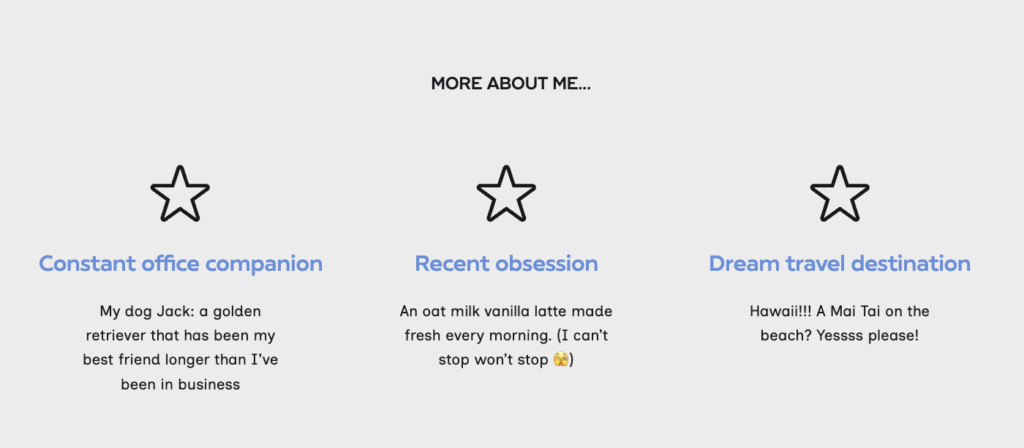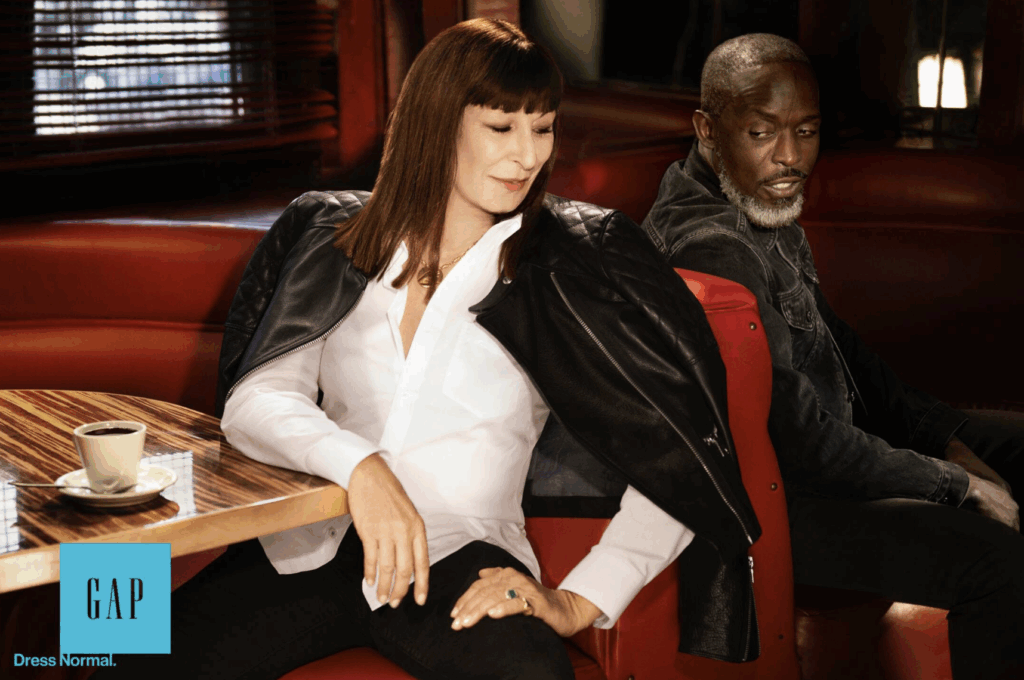I used to be such a hater when it came to those little sections on websites (specifically creative entrepreneur websites) that gave a little list of “peek into my life” moments.
Ya know, the ones that say things like:
“My recent obsession: an oat milk vanilla latte made fresh every morning. (I can’t stop won’t stop 🫣)”
Every time my eyes landed on one of these little tell-all sections, one thought would play in my head:
“Why for the love of everything that is good and beautiful in this world would anyone…ANYONE…care what this random web designer chooses as their wake-me-up drink of choice?”
For years as a website copywriter, I subtly steered clients away from these kinds of things in a “hmmmmm…maybe we talk about other things that, like, actually connect your audience with the benefits of your offer? Or that, like, actually show them why you’re uniquely qualified to solve their problems in a way others can’t?” kind of way.

But now I get it.
Because while there are wayyyyyyy better ways to accomplish what these tell-all sections are trying to do…
It’s undeniable that they ARE trying to accomplish *something.*
And it all comes down to the psychological power of identification.
Sooooo…what’s identification? And why should I care?
When thinking about identification, I like to lean on the teachings of a rhetorician (aka: a super smart, persuasion-obsessed scholar dude) named Kenneth Burke.
To Burke, you can’t persuade until you’ve found some good old-fashioned common ground.
Which means you also can’t successfully sell to people until you’ve found some common ground.
And, in fact, can’t even get people to listen to your message until you’ve found some common ground.
To get to that place of common ground?
You need to get people to identify with you in some way.
Which means that identification? It’s not just a buzzword: it’s the thing that helps determine whether people listen to your brand message…or don’t. (Not trying to be dramatic, just trying to be honest about the stakes here!)
GAP didn’t get this. And then they lost 6% of their sales.
Let’s time warp back to 2014.
“Normcore” was all the fashion rage around that time, with consumers celebrating basic, understated pieces over the stylized perfection they were used to seeing on the runway.
So the clothing company GAP decided to get in on the action.
They released an entire “Dress Normal” campaign, helmed by some Hollywood movie director bigwigs.
Sofia Coppola (of Marie Antoinette and Lost in Translation fame) directed the holiday ads. David Fincher (The Social Network, Se7en) leant his talents to the Fall 2014 campaign.
Idris Elba and Anjelica Huston even got in on the model action.
But the ads…didn’t work.
Why?
Well, even as GAP was telling people to “dress normal” (perhaps an inspiring, “be yourself and don’t feel like you have to fake it” message at its core)…
The situations the ads featured were, uh, not normal. And not relatable at all.
Celebrities in a full faces of makeup with:
1). Perfect styling
2). Perfect posing and
3). Perfect lighting?
Not normal.

Model-level *hot* people running up stairs in a black-and-white movie montage while flexing their clearly-toned butt to show off their jean pockets?
Not normal.
Where were the wrinkles in the shirts? Where was the messed-up hair? Where were the real people, wearing the real clothes they have to real wear to their real corporate 9-5s?
The answer was nowhere. All those things were nowhere to be found.
And people buying the clothes? They were nowhere to be found either.
When identification works, the payoff is more sales
So what does “working” look like?
It looks like totally-normal people huffing loudly and sweating profusely while running down an empty roadway while a narrator says: “Greatness — it’s just something we’ve made up.”
(^ The above example? It’s from Nike’s “Find Your Greatness” campaign.)
It looks like Patagonia releasing a “Don’t Buy This Jacket” ad in advance of the Black Friday season in 2011, where they sided with consumers on the not-so-great effects of consumerism. While also subtly poking at the way other companies lean into consumerism around that time of year.
Or Southwest Airlines with their long-running “Wanna Get Away” campaign, where consumers are reminded of how hard it can be to sit through über-embarrassing situations, with an out (low fare airplane tickets) conveniently suggested.
It looks like companies actually engaging their customers in a deep way. By showing — clearly and without question — that there is a sense of common ground at play.
But I’m not a Fortune 500 brand. How the heck am I supposed to make this identification thing work for me?
You don’t need to be Patagonia to put identification to work for your brand (and you don’t have to talk all day long about your morning latte order either).
Business coach Jenna Kutcher does it when she brings her kids into the conversation on her 1-million+ follower Instagram account, showing that it IS possible to achieve your big money dreams as a parent (something that her predominantly-female audience will likely relate to).
Imperfect Foods does it with website copy that constantly references the intersection of affordability and sustainability: showing that they empathize AND align with two main values at stake for their market.

Local businesses do it when they mention — front and center — that they’re alumni of the local college.
Or when they mention they’re women-owned. Or BIPOC-owned. Or family-owned. Or self-funded. Or B-Corp certified. Or “locally born and raised.”
And in doing so?
They do more than check a box in their marketing strategy.
They say, however indirectly:
“I get you. You get me. Let’s talk more?”
Make this a more on-the-ground marketing tip, please!
I got you!
Grab a pencil, pop open the Notes app on your computer, or find a nice stretch of beach where you can make some notes in the sand. (I’m kidding about that last one. Don’t use sand.)
Then answer these 4 questions (+ 1 bonus Q).
Answer them without thinking. Answer them by literally jotting down whatever comes into your brain. Answer them by thinking within the context of your market, but outside of it (in your personal life) too.
1). What do I (or, if you’re a bigger brand — your corporate team) have in common with my customers? (That runs deeper than our coffee orders…)
2). What values do we share?
3). What life experiences do we share?
4). What are we both really freaking tired of in our market?
All done? Perfect.
Now go back one-by-one through your responses, and ask yourself this question:
5). How can I SHOW my customers that we align in this way?

If you’re an organic spice brand that values experimentation in the kitchen and knows your customers do too? Great — build an experimentation series into your social media strategy that shows you being playful in the kitchen.
If you’re a digital marketing firm with a soft spot for cute, fuzzy koalas? Amazing — consider donating a portion of your profits to koala conservancy (and talking that up in your marketing).
If you and your customers are both really freaking tired of seeing accounting software that pretends taxes are easy? Cool — maybe it’s time for your brand to finally admit “Taxes are hard.”
So….to wrap up…why does identification matter again?
Because you can’t tell your perfect-fit people your whole story in the space of one ad, one headline, or one social media post.
But you can find more and better ways of getting them to consent to additional listening.
And that’s what identification really does —
Creates the kind of commonality that leaves people receptive to hearing your fuller story.
The kind of commonality that leaves them clicking over to your website to see more of what you’re about, instead of simply getting stuck on your Instagram main page.
The kind of commonality that gets them visiting your Services page, instead of getting lost somewhere between the start and end of your Home page.
The kind of commonality that helps you start to build a founded-on-something-real relationship with your audience. Instead of just selling at them.
Looks like it’s past time to put this theory into practice. Click here for a fully free, fully casual, fully no-pressure meeting of the minds. (Me. You. Lots of marketing smarts. Whatdaya say?)